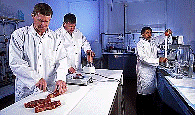United States Department of Agriculture: Agricultural Research Service, Lincoln, Nebraska
Date of this Version
5-2006
Document Type
Article
Citation
Agricultural Research Service U.S. Department of Agriculture, May 2006.
Abstract
It is important to match genetic potential of cow herds with the climatic environment and feed resources available for beef production in diverse regions of the U.S. and with consumer preferences for beef products that excel in consistency, leanness, palatability and tenderness. Since 1969, the Germplasm Evaluation Program at the U.S. Meat Animal Research Center has been conducted to characterize breeds representing diverse biological types for a wide spectrum of biological traits of economic importance in beef production. Previous results have shown that Bos indicus X Bos taurus (e.g., Brahman and Sahiwal, sired F1 cross cows out of Hereford and Angus dams) were exceptionally productive and efficient cows, especially in subtropical climates (e.g., Florida versus Nebraska). However, as the proportion Bos indicus increased the advantages of Bos indicus crosses were tempered by older age at puberty and reduced meat tenderness. This report focuses on characterization of alternative sources of tropically adapted germplasm compared to Angus and Hereford sired crosses.


